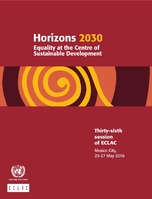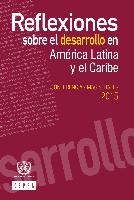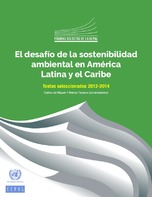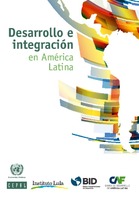- Biblioteca CEPAL
- Biblioguias
- biblioguias
- Raúl Prebisch and the challenges of development of the XXI century
- Development and environment
Raúl Prebisch and the challenges of development of the XXI century
Development and environment
Prebisch’s analysis of the structures of peripheral capitalism and the centre-periphery relationship made him aware of the need to incorporate environmental issues in his thinking. The dynamics of capital accumulation and income distribution were the source of environmental problems. He pointed out that the plundering of natural resources was part and parcel of the socioeconomic model of the “centres”; the degradation of the environment strengthened his conviction that an alternative development model was needed and that Latin America and the Caribbean needed to move forward in pursuit of an independent path.
His article “Biosphere and development” (CEPAL Review, December 1980) was a plea for attention, in the context of the second petroleum crisis (1979), to the consequences that the prevailing economic model was having on sustainable development. Prebisch addressed the underlying reasons for the irrational pattern of energy resource exploitation and the dire consequences that the development model was having on the biosphere following a decade in which new issues were coming to the fore. As regards the environment, the report of the Club of Rome The Limits to Growth (1972) had drawn attention to the planet’s limited carrying capacity and the future scarcity of natural resources. From the economic perspective, the decade was marked by rising prices for petroleum, on which the industrialization model was heavily dependent and this triggered a sharp inflationary spiral and a decline in economic activity in the countries affected, in particular those of the “centre”.
Production patterns:
The incentives for technological research set off a change, which, admittedly, succeeded in achieving constant increases in productivity but skewed innovation towards the intensive use of dirty energy, hydrocarbon-based products and natural resources. Cheap energy and ignorance of environmental externalities (together with failure to internalize costs) had generated, at the production level, an environmentally unsustainable path dependency.
The structural factors that account for differences between exports from the region and those of developed countries are highlighted in order to recall not just Latin America and the Caribbean’s natural resource dependency but also the difficulties the periphery will have in passing on to the centre the higher internal costs associated with environmental protection measures. The dialectic associated with the nature of the region’s integration in international value chains and the distribution of responsibilities for environmental externalities between the different producers (those that can “export” higher costs and those that cannot) and between the latter and consumers depending on their elasticities remains in force to this day.
Consumption patterns:
But Prebisch also severely criticizes the dynamic of the consumer society. Even if the benefits of technological progress succeed in incorporating the demand of new social strata, the consumerist model of the centre and consumer sovereignty as a dominant principle relegates basic human values (such as social equity, culture, life within the community, concern for the biosphere) to a secondary level. The periphery has imitated this model at the expense of social development and environmental sustainability.
This criticism of imitative capitalism, articulated in the document Structural Change for Equality: an Integrated Approach to Development (ECLAC, 2012), is also based on the realization that the development of a privileged consumer society is incompatible with the social integration of the masses, who are constantly excluded from opportunities for development – a central concern of the document Time for equality: closing gaps, opening trails (ECLAC, 2010). It is also incompatible with the correction of other flaws (for example environmental ones) in the system.
In short, in his visionary article, Prebisch poses some concepts that have been gaining greater visibility over time and which are at the heart of the concept of sustainable development, which was enunciated years later in the Brundtland Report (1987). In the following decades, reflection on the styles of development and changing production and consumption patterns was central both to ECLAC thinking and to the major development conferences, from the United Nations Conference on Environment and Development or Earth Summit (1992) to the United Nations Conference on Sustainable Development (Rio+20). Nevertheless, the challenges posed by Prebisch persist, many insufficiently heeded, and disillusionment with a development model that disregards the consequences for the biosphere and which fails to assume the true costs involved will continue to exacerbate existing problems and will narrow down the system’s options for perpetuating itself.
Interviews
HORIZONTES CEPAL – Capítulo 5: Entrevista a Joseluis Samaniego (2017 - 29:13)
Related documents
-
 The 2030 Agenda and the Sustainable Development Goals: An opportunity for Latin America and the Caribbean
by
Publication Date: 2017-0463 p. LC/G.2681/Rev.2 | LC/G.2681
The 2030 Agenda and the Sustainable Development Goals: An opportunity for Latin America and the Caribbean
by
Publication Date: 2017-0463 p. LC/G.2681/Rev.2 | LC/G.2681 -
 Horizons 2030: Equality at the centre of sustainable development
by
Publication Date: 2016-07Documento de posición presentado en el trigésimo sexto período de sesiones de la CEPAL, mayo 2016
Horizons 2030: Equality at the centre of sustainable development
by
Publication Date: 2016-07Documento de posición presentado en el trigésimo sexto período de sesiones de la CEPAL, mayo 2016 -
-
 Reflexiones sobre el desarrollo en América Latina y el Caribe: conferencias magistrales 2015
by
Publication Date: 2016-03
Reflexiones sobre el desarrollo en América Latina y el Caribe: conferencias magistrales 2015
by
Publication Date: 2016-03 -
 El desafío de la sostenibilidad ambiental en América Latina y el Caribe. Textos seleccionados 2012-2014
by
Publication Date: 2015Serie: Páginas Selectas de la CEPAL 148 p. LC/M.23
El desafío de la sostenibilidad ambiental en América Latina y el Caribe. Textos seleccionados 2012-2014
by
Publication Date: 2015Serie: Páginas Selectas de la CEPAL 148 p. LC/M.23

